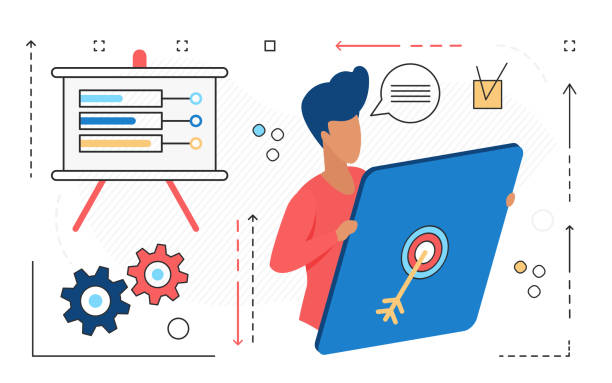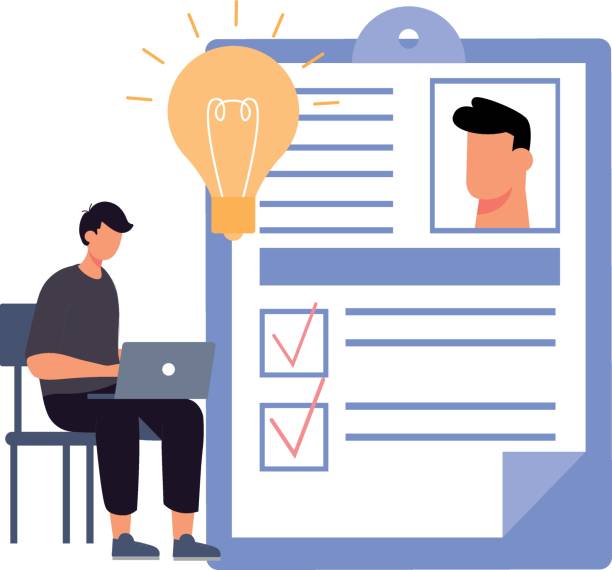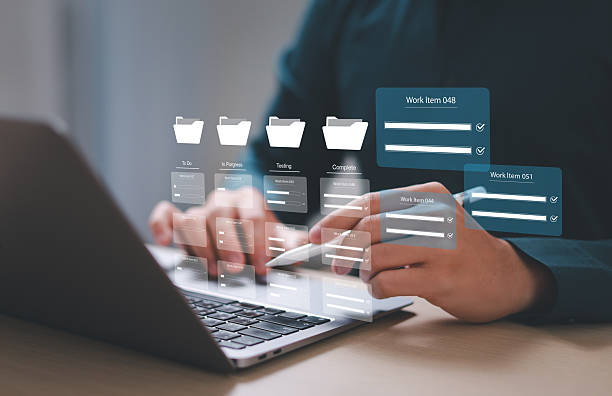Introduction to the Importance of Multilingual Website Design and Global Reach

In today’s world, where geographical boundaries are rapidly fading in the digital space, online presence is no longer limited to a specific language or culture.
#Multilingual_website_design is no longer a luxury option, but a strategic necessity for any business that dreams of global expansion and attracting international audiences.
With increasing internet access and the growth of emerging markets, users worldwide interact with the web in various languages.
Providing website content in the visitor’s native language not only significantly improves user experience but also builds a deeper sense of trust and connection between the business and the customer.
This approach helps you strengthen your digital marketing and gain a larger share of the global market.
Ignoring this important dimension means missing out on a huge portion of growth potential.
Multilingual website design allows businesses to convey their message to millions of people worldwide without the need for real-time human translators, providing countless opportunities to increase sales and brand recognition.
This is an essential step towards entering a new era of borderless e-commerce.
Are you dissatisfied with the low visitor-to-customer conversion rate on your e-commerce site?
Solve this problem forever with professional e-commerce website design by Rasaweb!
✅ Increase visitor-to-customer conversion rate
✅ Create an excellent user experience and build customer trust
⚡ Get free consultation
Key Benefits of Having a Multilingual Website for Business Development

Having a multilingual website goes beyond mere word-for-word translation; it’s a comprehensive strategy for penetrating new markets and enhancing your brand’s credibility.
One of the most significant benefits of multilingual website design is a dramatic increase in access to global audiences.
Imagine your website is only in Persian; in this scenario, all non-Persian speaking users would be deprived of accessing your content.
However, by providing content in common world languages such as English, Spanish, Chinese, or Arabic, you open new doors to larger and more profitable markets.
This not only helps you attract more traffic but also increases the visitor-to-customer conversion rate.
When a user can read content in their native language, they are more likely to trust and make a purchase.
Furthermore, multilingual website design significantly improves your SEO and search engine rankings.
Search engines like Google prefer websites that offer quality content in various languages.
Proper use of hreflang tags and an appropriate URL structure sends strong signals to search engines that your website is targeted at international audiences.
This leads to increased visibility in local and global search results.
Finally, building a multilingual website demonstrates your respect for different cultures and languages, which in turn strengthens your brand internationally and fosters more stable relationships with foreign customers.
This is a smart investment for the future of any business.
Challenges and Technical Considerations in Multilingual Website Design and Their Solutions

Although the benefits of multilingual website design are numerous, its implementation requires a deep understanding of technical challenges and meticulous planning.
One of the most important considerations is choosing the appropriate URL structure.
Should one use subdomains (e.g., en.example.com), subdirectories (e.g., example.com/en/), or country-specific top-level domains (e.g., example.de)? Each has its pros and cons in terms of SEO, hosting, and management.
Another challenge is content translation management; ensuring the accuracy and quality of translations, especially for specialized or legal content, is of paramount importance.
Utilizing content management systems (CMS) that natively support multilingual capabilities or powerful plugins can facilitate this process.
The next topic is optimization for international SEO.
Correct use of the hreflang tag to point to different language versions of a page helps search engines display the appropriate version to the user.
Furthermore, Unicode support for proper display of characters from various languages and Right-to-Left (RTL) for languages like Persian and Arabic are crucial technical aspects.
Finally, there’s the discussion of site performance.
Adding more languages can increase data volume and requests, which requires precise server and code optimization.
These technical considerations are an integral part of a successful multilingual website design project, without which the risk of project failure increases.
Comparison of URL Structures for Multilingual Websites
| Structure Type | Example | Advantages | Disadvantages |
|---|---|---|---|
| Country Code Top-Level Domains (ccTLD) | example.de | Strongest geographic signal, SEO separation | High cost, difficult management, requires separate IP |
| Subdirectories | example.com/de/ | Good SEO, easier management, lower cost | Weaker geographic signal than ccTLD |
| Subdomains | de.example.com | Easier management, content separation | More complex SEO, requires more precise settings |
| URL Parameters | example.comNULLlang=de | Simple implementation | Worst option for SEO, crawling issues |
Choosing the Best URL Strategy for Multilingual Websites with a Focus on SEO

The URL strategy is one of the most crucial technical decisions in the multilingual website design process, directly impacting SEO and user experience.
As mentioned in the previous table, there are three main options for multilingual website URL structures: Country Code Top-Level Domains (ccTLDs), subdirectories, and subdomains.
Each has its specific advantages and disadvantages, and the best option should be chosen based on business goals and available resources.
Country code top-level domains like .de for Germany or .fr for France provide the strongest geographic signal to search engines.
This option is ideal for businesses aiming for deep penetration into specific country markets.
However, the need to purchase and manage multiple domains, separate hosting, and build backlinks for each domain, can be costly and complex.
Subdirectories (such as example.com/en/) are the most common and recommended option by Google.
They benefit from the authority of the main domain, are relatively easier to manage, and do not require purchasing additional domains.
This structure helps search engines easily recognize different languages and is highly efficient for sites with a moderate number of languages.
Subdomains (such as en.example.com) place content for each language in a separate subdomain.
From Google’s perspective, subdomains largely act like independent domains and may require separate SEO efforts, although Google has become smarter in recognizing the connection between them in recent years.
This option can be suitable for large organizations with different language sections.
The correct selection of these structures is crucial for the success of a multilingual website design project, as changing it in the future can be very costly and complex.
Is your current e-commerce website not generating the sales you expect?
Rasaweb is a specialist in professional e-commerce website design!
✅ An attractive and user-friendly website aimed at increasing sales
✅ High speed and security for an ideal shopping experience⚡ Get a free consultation on online store design with Rasaweb!
Content and Translation Management in a Multilingual Website Design Project with a Professional Approach

One of the biggest challenges in implementing a multilingual website is efficient content and translation process management.
Simply translating words from one language to another is not enough; the content must also be culturally localized to connect with target audiences in each geographical region.
This process includes considering local idioms, currencies, dates, and even differences in color schemes and symbols.
For effective content management, choosing a Content Management System (CMS) that natively supports multilingual capabilities or through powerful plugins is crucial.
CMSs like WordPress with plugins such as WPML or Polylang, or Joomla! or Drupal, which were designed for multilingualism from the outset, can facilitate the content creation and update process.
These systems allow you to link different versions of a page in various languages and easily switch between them.
Regarding the translation process, using professional native-speaking translators is highly recommended.
Machine translators like Google Translate can be useful for general understanding, but for sensitive, marketing, or specialized content, their errors can harm your brand’s credibility.
Some companies use a combination of machine translation and human post-editing to reduce costs and increase speed.
Furthermore, creating a Glossary & Style Guide for translators helps maintain consistency and quality of content across all languages.
Content management in creating multicultural websites is an ongoing process that requires regular monitoring and updates to remain fresh and relevant.
SEO Optimization for Multilingual Websites: Key Tips for Better Ranking

SEO for multilingual websites has its own complexities that go beyond traditional SEO, and special attention must be paid to it during the multilingual website design process.
The main goal is to ensure that search engines display the correct language versions to users in appropriate geographical regions.
One of the most important tools for this is the hreflang tag.
This tag is used in the HTML header or sitemap and tells search engines that a page has alternate versions for different languages or regions.
Incorrect use of hreflang can lead to SEO issues like duplicate content, so precision in its implementation is essential.
Keyword research for each language is also crucial.
Simply translating keywords from one language to another is not enough, as user search behavior and terminology used differ across languages.
For example, a marketing term in English might have multiple equivalents or different popularity in Spanish.
Using local keyword research tools and cultural understanding helps you find suitable keywords for each target market.
Furthermore, optimizing Title Tags and Meta Descriptions for each language and region is highly important.
These tags not only help search engines understand the page content but also encourage users to click.
Finally, local backlink building can also help strengthen page rankings in specific regions.
Attracting backlinks from reputable and relevant websites for each language and region indicates your local authority and can have a positive impact on international SEO.
Adhering to these tips is the foundation for successful optimization of multilingual websites for search engines.
User Experience (UX) in Multilingual Website Design and the Importance of Localization

User Experience (UX) in multilingual website design goes beyond mere text translation; it means deeply understanding the cultural, visual, and interactive differences of users in various parts of the world.
A successful UX in multilingual sites ensures that users, regardless of their native language, can easily interact with the website and find the information they need.
One of the first steps is to provide a clear and accessible language selection option.
This is typically done as a dropdown menu in the header or footer of the site, or via country flags, but it must be designed so that users can quickly find their desired language.
Localization plays a vital role in UX.
This involves adapting content to the cultural norms and expectations of users.
For example, the display format of dates and times (e.g., day/month/year or month/day/year), units of measurement (metric or imperial), phone number formats, and even color naming can differ between cultures.
Images and graphics must also be carefully chosen to be culturally appropriate and appealing, and to avoid any offense or misunderstanding.
Additionally, for languages like Persian or Arabic that are written Right-to-Left (RTL), the entire User Interface (UI) must be mirrored; this includes the orientation of text, images, menus, and buttons.
Load Time is also an important UX factor, especially for users in regions with slower internet.
Ensuring appropriate CDN (Content Delivery Network) hosting and optimizing images and scripts for each language version helps improve speed.
Ignoring these details in multilingual website development can lead to a poor user experience and consequently loss of visitors and customers.
Therefore, investing in UX localization is as important as content translation.
Key Elements in User Experience (UX) Localization
| UX Element | Localization Considerations | Example |
|---|---|---|
| Text Direction | Support for RTL (Right-to-Left) for languages like Persian, Arabic, Hebrew | Placing menus and buttons on the left for RTL |
| Date and Time Formats | Differences in day/month/year, AM/PM display | 2024/05/15 (ISO) vs. 15/05/2024 (UK) vs. 05/15/2024 (US) |
| Units of Measurement | Use of metric or imperial system | Centimeters/Meters vs. Inches/Feet |
| Currency Display | Currency symbol, decimal separator, thousands separator | ?,234.56 (US) vs. 1.234,56 € (EU) |
| Images and Symbols | Cultural appropriateness of images and symbols | Using images of people with racial and cultural diversity |
| Phone Numbers and Addresses | Local formats for phone numbers and addresses | Country code, area code, address order in countries |
Popular Tools and Plugins for Multilingual Website Design: Practical Recommendations

To facilitate the multilingual website design process, various tools and plugins have been developed that can significantly save time and cost.
Choosing the right tool depends on your Content Management System (CMS) and the specific needs of the project.
For WordPress, the WPML (WordPress Multilingual Plugin) plugin is one of the most popular and powerful options.
This plugin allows the translation of posts, pages, categories, tags, menus, and even widgets.
WPML supports hreflang tags and is compatible with many popular themes and plugins.
Another option is Polylang, which offers a lighter and free solution for multilingualism in WordPress.
Although it has fewer features than WPML, it is suitable for many small to medium-sized websites.
For websites built with Joomla!, the JoomFish (or Falang) component and Joomla’s native multilingual capabilities offer robust solutions.
Drupal also natively supports multilingualism and, with powerful modules like Language and Internationalization (i18n), provides extensive features for managing multilingual content.
In addition to CMS plugins, automatic translation tools and Translation Management Systems (TMS) platforms like MemoQ or Trados can also be useful for managing large translation projects.
These tools provide features for managing glossaries, Translation Memories, and quality control tools, which help maintain consistency and reduce costs in the long run.
Proper use of these tools can transform the complex multilingual website design process into an efficient and successful experience.
Are you tired of your company’s website not meeting your expectations? With Rasaweb, design a professional website that truly represents your business.
✅ Increase attraction of new customers and sales leads
✅ Boost your brand’s credibility and trust with your audience
⚡ Get a free website design consultation!
The Future of Multilingual Website Design and New Trends: Exciting Developments

The future of multilingual website design is inextricably linked with significant advancements in technology, particularly in artificial intelligence and machine translation.
These new trends not only make the translation process more efficient but also offer new possibilities for personalizing and localizing the user experience.
One of the most important future trends is Neural Machine Translation (NMT), which is becoming increasingly accurate and natural.
AI algorithms can translate not only words but also understand the meaning and tone of sentences, leading to much higher quality translations.
These advancements can significantly reduce the time and cost of initial translation, although human review and localization for sensitive and marketing content are still necessary.
Another trend is content personalization based on user language and geographical location.
By using location and language data, websites will be able to automatically display content that is not only in the correct language but also more culturally and regionally relevant.
This includes offering specific products or services in a region, local events, or even special offers based on weather.
Furthermore, multilingual voice search and interaction with AI chatbots capable of answering user questions in various languages are expanding.
This makes information more accessible to users worldwide and elevates the user experience to a new level.
Overall, the future of multilingual websites is moving towards greater automation, more precise localization, and fully personalized user experiences, where language barriers will practically become invisible.
How to Successfully Start a Multilingual Website Design Project: A Step-by-Step Guide

Starting a multilingual website design project can seem daunting at first, but with meticulous planning and following a structured approach, it can be successfully completed.
The first step is to define your goals and target audience.
Which languages should you support? Which markets are a priority for you? Is your focus on SEO or merely providing information? Answering these questions will define the overall direction of the project.
The next step is choosing the appropriate technology.
As mentioned earlier, selecting the CMS and related multilingual plugins is very important.
Does your current infrastructure have the capability to be upgraded for multilingualism, or do you need a new solution? A thorough review of options and consultation with web development specialists will prevent incorrect decisions.
Then, it’s time to develop a content and translation strategy.
Decide which sections of the site need translation (all or just the main sections).
Determine the source of translations: in-house translators, professional translation agencies, or a combination of both.
To maintain quality and consistency, creating a glossary and style guide for translators is essential.
Also, ensure that a review and localization process is considered so that the content is culturally appropriate.
Finally, don’t forget technical implementation and SEO optimization.
This includes correct implementation of hreflang tags, URL optimization, and ensuring high loading speed for all language versions.
Do you need a specialized team to manage your multilingual website, or can you manage it internally? These important questions require deep consideration.
This path will transform you from a single-language website into a global platform, and this investment will undoubtedly yield significant returns.
Frequently Asked Questions
| No. | Question | Answer |
|---|---|---|
| 1 | What is multilingual website design? | Multilingual website design means building a website whose content is available to users in several different languages. This is usually done through a simple user interface for language switching. |
| 2 | Why should we design a multilingual website? | Multilingual website design helps you reach a wider audience worldwide, provide a better user experience for international users, and improve your global SEO. |
| 3 | What are the main methods for implementing multilingualism on a website? | The main methods include using subdomains, subdirectories, or URL parameters for each language, as well as using entirely separate domains for each language. |
| 4 | For SEO, is it better to use a subdirectory or a subdomain? | From an SEO perspective, both subdirectory and subdomain methods can be effective. However, many SEO experts prefer subdirectories due to better transfer of main domain authority. |
| 5 | What are the important points in translating multilingual website content? | Translation should be done by native translators, content should be localized in addition to translation to match the target audience’s culture, and pure machine translation should be avoided. |
| 6 | What is the role of the hreflang tag in multilingual site SEO? | The hreflang tag helps search engines like Google display the correct language and regional version of a page to the appropriate users, which also prevents duplicate content issues. |
| 7 | Can a website be made multilingual without coding? | Yes, in Content Management Systems (CMS) like WordPress, powerful plugins like WPML or Polylang exist that allow multilingualizing a website without the need for coding. |
| 8 | What are the challenges of multilingual website design? | Challenges include translation management, content localization, adherence to SEO principles for each language, technical support for different languages, and ensuring design consistency across different languages. |
| 9 | What is the difference between translation and localization? | Translation is merely converting words from one language to another, while localization involves adapting content to the culture, customs, currency, date and time formats, and even appropriate colors for the target audience. |
| 10 | What is the best User Experience (UX) for language switching? | A clear and accessible language switch (usually in the header or footer), using language names instead of flags (due to regional diversity), and maintaining the user’s position after language change are important UX considerations. |
And other services of Rasa Web advertising agency in the field of advertising
Smart Website Development: A dedicated service for growth in click-through rates based on the use of real data.
Smart Google Ads: A new service for enhanced campaign management through precise audience targeting.
Smart Customer Journey Map: Designed for businesses seeking to increase click-through rates through Google Ads management.
Smart SEO: Professional optimization for online growth using key page optimization.
Smart Conversion Rate Optimization: A dedicated service for growing customer acquisition based on user experience customization.
And over hundreds of other services in the field of internet advertising, advertising consultation, and organizational solutions.
Internet Advertising | Advertising Strategy | Advertorial
Sources
? Transform your business in the digital world with Rasaweb Afarin. We pave your path to online success by providing comprehensive digital marketing services including multilingual website design, SEO, and social media management. For a free consultation and to learn more about our solutions, contact us today.
📍 Tehran, Mirdamad Street, next to Bank Markazi, Southern Kazerun Alley, Ramin Alley, No. 6


